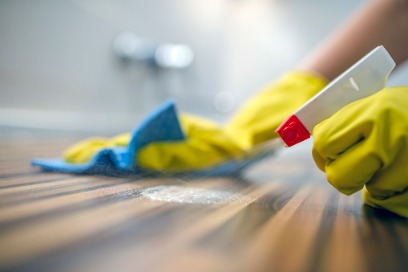While you’re busy cooking up delicious food in the kitchen, there’s something else brewing in its corners and crevices – something far less appetising. From mould and spores to germs and bacteria, our kitchens can be a breeding ground for all sorts of nastiness when they aren’t cleaned regularly.
The last thing you want is to have the place where you prepare your meals crawling with unpleasant things that can be easily avoided. But sometimes, these germs and spills can be lurking in the areas we don’t always think about – allowing them to spread and grow unbeknownst to you and your family.
During the festive period, you might’ve let your kitchen cleanliness take a backseat. So, to help you get back into the swing of keeping your kitchen spick and span, we’re dishing the dirt on the places you shouldn’t miss out on cleaning next time things get on the messy side. And, we’re providing a few recommendations that we hope can help you get them back to their sparkling best.
- Kitchen sponges
It’s probably no surprise that sponges and dishcloths harbour so much dirt. They come into contact with so many dirty kitchen utensils, pots and pans that they’re bound to accumulate their fair share of filth. And when they aren’t properly sanitised, they can become a site for worrying things like bacteria, so it’s probably a good idea to change out your sponges often or microwave them for about two minutes to kill bacteria.
This Good Housekeeping guide is a great place to start when you’re cleaning sponges.

- Dishwasher
How can a dishwasher get dirty? Its only job is to clean things by spraying steaming hot jets of water and detergent around – thereby cleaning itself, surely? Well, it’s not quite as simple as that. The near-constant damp causes mould and hard-water to build up, while trapped food waste can cause bad odours and bacteria.
Rinsing and cleaning the filter weekly helps here, while a monthly top-up of rinse aid and using a dishwasher cleaner stops dishes streaking, softens the water and prevents limescale. Also, every six months, running the dishwasher empty on a hot setting will stop your machine getting whiffy over time.
- Blender
Blenders are great for making soups, smoothies and sauces, but anyone who uses one regularly will know: they can be a bit of a hassle to clean. What’s more, doing a poor job of cleaning your blender will allow mildew and mould to grow, as moisture seeps down into the blade area. The best thing to do is clean it immediately after use – here’s how:
Step 1: Fill the pitcher halfway with hot water
Step 2: Add some washing up liquid
Step 3: Put the lid on and turn the blender on for one to two minutes
Step 4: Pour the contents in the sink and rinse the pitcher
Step 5: Fill with warm water and run it for another minute
Step 6: Rinse out and dry
- Microwave
When it comes to your microwave, it can be a case of “out of sight, out of mind”. But every time you open up the microwave door and see soup spatter and sauce spillages everywhere, that’s where things become a concern. Stop the spread of bacteria by wiping things down with a disinfectant at least once a week, and be sure to clean up spills as they happen.
Another helpful trick is to fill a glass with vinegar, put it in the microwave, run the appliance for a minute and allow the vapours to circulate. Give it a dry and then it’s good to go for your next meal.

- Vegetable drawer
Unless you’re constantly getting your five a day, nothing turns veg into a soggy, mouldy mess like the vegetable drawer in your fridge. Throw your favourite veggies in here, allow a few weeks’ worth of moisture to work its magic and hey presto: soggy, mouldy, inedible vegetables.
Get into the habit of taking out these drawers and wiping them down with warm water and a tablespoon of baking soda to reduce the risk of mould and help keep the healthy stuff fresher for longer.
- Under the sink
Tucked away behind a plethora of kitchen sprays, rubber gloves and dishwasher tablets, the piping that’s connected to your sink leaves all kinds of opportunity for mould and mildew thanks to its wet and dank surroundings. Be sure to fix any leaks down there before cleaning away the mould that’s accumulated, followed by a disinfectant of bleach and water. Keep the cabinet doors open and let the area dry out completely.
- Tin openers
Unassuming yet essential, no kitchen is without a tin opener. But despite how frequently they’re used, you might not think to give this trusty piece of equipment the cleaning it requires. Tin openers can get covered in all sorts of mould, bacteria and germs over time if they aren’t kept clean.
Check to see if yours is dishwasher safe, throw it in with your next load and don’t leave things up to chance. Alternatively, wash it with hot soapy water and leave it to dry with the dishes.
- Fridge handle
While you may regularly clean the inside of your fridge, do you give the outside the same care and attention? Bacteria is easily transferred in the kitchen, and with yourself, as well as family and friends opening the fridge, that’s a lot of hands that have come into contact with the handle.

Also, keep in mind the amount of bacteria that might be on the food itself. Meat, fruit and veg can be covered in all sorts if it hasn’t been washed properly, so transferring these foods to and from the fridge can easily spread germs and bacteria. Be sure to wipe down the door and handle with antibacterial spray on a regular basis.
- The underside of surfaces
A kitchen has all sorts of nooks and crannies where dirt can get into. So, while you might’ve taken care of any spillages on the surface, their undersides can get dirty if spills have made their way underneath. Spills that solidify and get sticky are like a magnet for ants and insects, so make sure to clean under these surfaces next time you give your kitchen a once over.
- Kitchen bin
Obviously, you take your rubbish out regularly, but do you give the bin in your kitchen a proper clean? If not, there could be all sorts of bacteria and unpleasant smells you’re leaving behind. Make sure you’re cleaning it properly by using a bristled brush to scrub it down and then spraying it with antibacterial spray to make sure nothing’s lingering around afterwards.
We hope this article has inspired you to start the new year off with a kitchen spruce up. Looking for further cleaning tips and recipe ideas? Check out the new Oven Pride blog or visit our homepage to learn more about our unique oven-cleaning formula.








